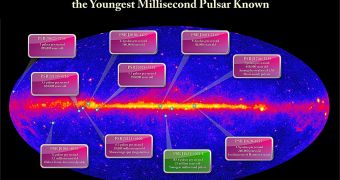In a paper published in the November 3 issue of the top journal Science, an international collaboration of astronomers announces that the NASA Fermi Gamma-ray Space Telescope was recently able to accomplish a number of milestone. They were all reached during its latest survey.
One of the most important discoveries the telescope made was that of a millisecond pulsar that is only 25 million years old. This is the youngest such object found to date, researchers say, and the finding could help them reshape existing theories on how such objects form.
A pulsar is a special type of neutron star that is capable of emitting electromagnetic energy at regular intervals, mostly from its poles. If the beam of energy is released in the same plane as Earth's orbit, then we perceive it as a lighthouse in space, hence the name pulsar.
A millisecond pulsar differs from a standard pulsar through the fact that it spins tremendously fast. The fast-moving object in this class discovered to date revolves around itself 43,000 times per minute.
What is very interesting about neutron stars in general is the fact that they contain several million times the mass of our planet focused in a tiny ball, whose diameter is smaller than a large city. This means that the matter within is extremely crushed and dense.
The Science paper also describes how an additional batch of 9 pulsars were discovered in Ferni data, marking yet another significant achievement for this renowned instrument. “With this new batch of pulsars, Fermi now has detected more than 100” such objects, expert Pablo Saz Parkinson explains.
This “is an exciting milestone when you consider that, before Fermi's launch in 2008, only seven of them were known to emit gamma rays,” adds the investigator, who holds an appointment as an astrophysicist at the University of California in Santa Cruz (UCSC) Santa Cruz Institute for Particle Physics (SCIPP).
The thing that mostly surprised investigators about the new, young pulsar is the fact that it's many times younger than the previous record-holder. Generally, the youngest objects in this class are about 1 billion years old. The new millisecond pulsar has been named PSR J1823−3021A.
“It's amazing that all of the gamma rays we see from this cluster are coming from a single object. It must have formed recently based on how rapidly it's emitting energy,” Paulo Freire explains.
“It's a bit like finding a screaming baby in a quiet retirement home,” adds the scientist, who holds an appointment at the Max Planck Institute for Radio Astronomy, in Bonn, Germany.
“We adapted methods originally devised for studying gravitational waves to the problem of finding gamma-ray pulsars, and we were quickly rewarded,” concludes the director of the Max Planck Institute for Gravitational Physics, in Hannover, Germany, Bruce Allen.

 14 DAY TRIAL //
14 DAY TRIAL //